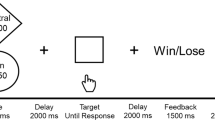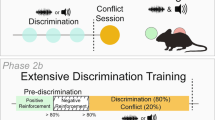Abstract
Positive expectations contribute to the clinical benefits of the placebo effect1,2. Such positive expectations are mediated by the brain's reward system3,4; however, it remains unknown whether and how reward system activation affects the body's physiology and, specifically, immunity. Here we show that activation of the ventral tegmental area (VTA), a key component of the reward system, strengthens immunological host defense. We used 'designer receptors exclusively activated by designer drugs' (DREADDs) to directly activate dopaminergic neurons in the mouse VTA and characterized the subsequent immune response after exposure to bacteria (Escherichia coli), using time-of-flight mass cytometry (CyTOF) and functional assays. We found an increase in innate and adaptive immune responses that were manifested by enhanced antibacterial activity of monocytes and macrophages, reduced in vivo bacterial load and a heightened T cell response in the mouse model of delayed-type hypersensitivity. By chemically ablating the sympathetic nervous system (SNS), we showed that the reward system's effects on immunity are, at least partly, mediated by the SNS. Thus, our findings establish a causal relationship between the activity of the VTA and the immune response to bacterial infection.
This is a preview of subscription content, access via your institution
Access options
Subscribe to this journal
Receive 12 print issues and online access
$209.00 per year
only $17.42 per issue
Buy this article
- Purchase on Springer Link
- Instant access to full article PDF
Prices may be subject to local taxes which are calculated during checkout




Similar content being viewed by others
References
Howick, J. et al. Placebo use in the United Kingdom: results from a national survey of primary care practitioners. PLoS One 8, e58247 (2013).
Tilburt, J.C., Emanuel, E.J., Kaptchuk, T.J., Curlin, F.A. & Miller, F.G. Prescribing 'placebo treatments': results of national survey of US internists and rheumatologists. BMJ 337, a1938 (2008).
de la Fuente-Fernández, R. et al. Expectation and dopamine release: mechanism of the placebo effect in Parkinson's disease. Science 293, 1164–1166 (2001).
Scott, D.J. et al. Placebo and nocebo effects are defined by opposite opioid and dopaminergic responses. Arch. Gen. Psychiatry 65, 220–231 (2008).
Benedetti, F., Carlino, E. & Pollo, A. How placebos change the patient's brain. Neuropsychopharmacology 36, 339–354 (2011).
Walach, H. Placebo controls: historical, methodological and general aspects. Phil. Trans. R. Soc. Lond. B 366, 1870–1878 (2011).
D'Acquisto, F., Rattazzi, L. & Piras, G. Smile—it's in your blood! Biochem. Pharmacol. 91, 287–292 (2014).
Segerstrom, S.C. & Miller, G.E. Psychological stress and the human immune system: a meta-analytic study of 30 years of inquiry. Psychol. Bull. 130, 601–630 (2004).
Barak, Y. The immune system and happiness. Autoimmun. Rev. 5, 523–527 (2006).
Eisenberger, N.I. & Cole, S.W. Social neuroscience and health: neurophysiological mechanisms linking social ties with physical health. Nat. Neurosci. 15, 669–674 (2012).
Fredrickson, B.L. et al. A functional genomic perspective on human well-being. Proc. Natl. Acad. Sci. USA 110, 13684–13689 (2013).
Mittwoch-Jaffe, T., Shalit, F., Srendi, B. & Yehuda, S. Modification of cytokine secretion following mild emotional stimuli. Neuroreport 6, 789–792 (1995).
Segerstrom, S.C. & Sephton, S.E. Optimistic expectancies and cell-mediated immunity: the role of positive affect. Psychol. Sci. 21, 448–455 (2010).
Segerstrom, S.C., Taylor, S.E., Kemeny, M.E. & Fahey, J.L. Optimism is associated with mood, coping and immune change in response to stress. J. Pers. Soc. Psychol. 74, 1646–1655 (1998).
Nieh, E.H., Kim, S.Y., Namburi, P. & Tye, K.M. Optogenetic dissection of neural circuits underlying emotional valence and motivated behaviors. Brain Res. 1511, 73–92 (2013).
Russo, S.J. & Nestler, E.J. The brain reward circuitry in mood disorders. Nat. Rev. Neurosci. 14, 609–625 (2013).
Schultz, W. Updating dopamine reward signals. Curr. Opin. Neurobiol. 23, 229–238 (2013).
Armbruster, B.N., Li, X., Pausch, M.H., Herlitze, S. & Roth, B.L. Evolving the lock to fit the key to create a family of G-protein-coupled receptors potently activated by an inert ligand. Proc. Natl. Acad. Sci. USA 104, 5163–5168 (2007).
Huston, J.P., Silva, M.A., Topic, B. & Müller, C.P. What's conditioned in conditioned place preference? Trends Pharmacol. Sci. 34, 162–166 (2013).
Gunaydin, L.A. et al. Natural neural projection dynamics underlying social behavior. Cell 157, 1535–1551 (2014).
Bendall, S.C. et al. Single-cell mass cytometry of differential immune and drug responses across a human hematopoietic continuum. Science 332, 687–696 (2011).
Gratton, A., Hoffer, B.J. & Gerhardt, G.A. Effects of electrical stimulation of brain reward sites on release of dopamine in rat: an in vivo electrochemical study. Brain Res. Bull. 21, 319–324 (1988).
Connolly, B.S. & Lang, A.E. Pharmacological treatment of Parkinson disease: a review. J. Am. Med. Assoc. 311, 1670–1683 (2014).
Elenkov, I.J., Wilder, R.L., Chrousos, G.P. & Vizi, E.S. The sympathetic nerve—an integrative interface between two supersystems: the brain and the immune system. Pharmacol. Rev. 52, 595–638 (2000).
Koopman, F.A. et al. Restoring the balance of the autonomic nervous system as an innovative approach to the treatment of rheumatoid arthritis. Mol. Med. 17, 937–948 (2011).
Nakamoto, T. et al. Co-activation of renal sympathetic neurons and somatic motor neurons by chemical stimulation of the midbrain ventral tegmental area. J. Appl. Physiol. 110, 1342–1353 (2011).
Kostrzewa, R.M. & Jacobowitz, D.M. Pharmacological actions of 6-hydroxydopamine. Pharmacol. Rev. 26, 199–288 (1974).
Lacosta, S., Merali, Z., Zalcman, S. & Anisman, H. Time-dependent in vivo mesolimbic dopamine variations following antigenic challenge. Brain Res. 664, 225–230 (1994).
Saurer, T.B., Ijames, S.G. & Lysle, D.T. Evidence for the nucleus accumbens as a neural substrate of heroin-induced immune alterations. J. Pharmacol. Exp. Ther. 329, 1040–1047 (2009).
Balfour, M.E., Yu, L. & Coolen, L.M. Sexual behavior and sex-associated environmental cues activate the mesolimbic system in male rats. Neuropsychopharmacology 29, 718–730 (2004).
Hajnal, A., Smith, G.P. & Norgren, R. Oral sucrose stimulation increases accumbens dopamine in the rat. Am. J. Physiol. Regul. Integr. Comp. Physiol. 286, R31–R37 (2004).
Enck, P., Benedetti, F. & Schedlowski, M. New insights into the placebo and nocebo responses. Neuron 59, 195–206 (2008).
National Research Council. Guide for the Care and Use of Laboratory Animals 8th edn. (The National Academies Press, 2011).
Lammel, S. et al. Diversity of transgenic mouse models for selective targeting of midbrain dopamine neurons. Neuron 85, 429–438 (2015).
Rogan, S.C. & Roth, B.L. Remote control of neuronal signaling. Pharmacol. Rev. 63, 291–315 (2011).
Bruggner, R.V., Bodenmiller, B., Dill, D.L., Tibshirani, R.J. & Nolan, G.P. Automated identification of stratifying signatures in cellular subpopulations. Proc. Natl. Acad. Sci. USA 111, E2770–E2777 (2014).
Parmigiani, G., Garrett, E.S., Anbazhagan, R. & Gabrielson, E. A statistical framework for expression-based molecular classification in cancer. J. R. Stat. Soc. Series B Stat. Methodol. 64, 717–736 (2002).
Heller, E.D., Leitner, H., Drabkin, N. & Melamed, D. Passive immunization of chicks against Escherichia coli. Avian Pathol. 19, 345–354 (1990).
Acknowledgements
We would like to thank A. Ziv-Kenet for his help with CyTOF data analysis, A.D. Eban-Rothchild, C. Tourino, D. Melamed, N. Karin, G. Wildbaum, R. Hershberg and M. Rahat for helpful discussions, A. Mor, F. Zaknoon, J. Jammal, S. Yaron and S. Katz for their help with bacterial experiments, Y. Posen, G. Ginzburg and E. Reisin-Tzur for editing the paper, H. Amitay for her help with the behavioral analysis, and O. Goldberger and the Biomedical core facility at the Technion Faculty of Medicine for technical support. This research was supported by the FP-7-CIG grant 618654 (A.R.), the Israel Science Foundation (ISF) grants 1862/15 (A.R.) and 1365/12 (S.S.S.-O.), the Technion V.P.R. Fund–Malat Family (A.R.), the Adelis Foundation (A.R.) and the Rappaport Institute of Biomedical Research (S.S.S.-O.).
Author information
Authors and Affiliations
Contributions
T.L.B.-S. designed and carried out all of the experiments, interpreted the results and wrote the manuscript; H.A.-D. contributed to the experimental design, carried out experiments, contributed to data analysis and to the manuscript; T.D. and E.S. designed, performed and analyzed the CyTOF experiments and contributed to the manuscript; B.K. and M.S. contributed to the experimental design and execution of the experiments, contributed to analysis of the results and contributed to the manuscript; N.L.G. contributed to the interpretation of the results and the writing the manuscript; Y.A. contributed to the CyTOF data analysis; F.H. contributed to the experimental design and data interpretation; S.S.S.-O. designed and analyzed the CyTOF experiments, contributed with the interpretation of results and wrote the manuscript; and A.R. conceived the project, contributed to the experimental design and the interpretation of results, and wrote the manuscript.
Corresponding authors
Ethics declarations
Competing interests
The authors declare no competing financial interests.
Supplementary information
Supplementary Text and Figures
Supplementary Tables 1–2 and Supplementary Figures 1–13 (PDF 9234 kb)
Rights and permissions
About this article
Cite this article
Ben-Shaanan, T., Azulay-Debby, H., Dubovik, T. et al. Activation of the reward system boosts innate and adaptive immunity. Nat Med 22, 940–944 (2016). https://doi.org/10.1038/nm.4133
Received:
Accepted:
Published:
Issue Date:
DOI: https://doi.org/10.1038/nm.4133
This article is cited by
-
Comparative rhythmic transcriptome profiling of human and mouse striatal subregions
Neuropsychopharmacology (2024)
-
The Fifth Bioelectronic Medicine Summit: today’s tools, tomorrow’s therapies
Bioelectronic Medicine (2023)
-
Central regulation of stress-evoked peripheral immune responses
Nature Reviews Neuroscience (2023)
-
Neuroinflammatory Response in Reward-Associated Psychostimulants and Opioids: A Review
Cellular and Molecular Neurobiology (2023)
-
Tumor suppression and improvement in immune systems by specific activation of dopamine D1-receptor-expressing neurons in the nucleus accumbens
Molecular Brain (2022)



